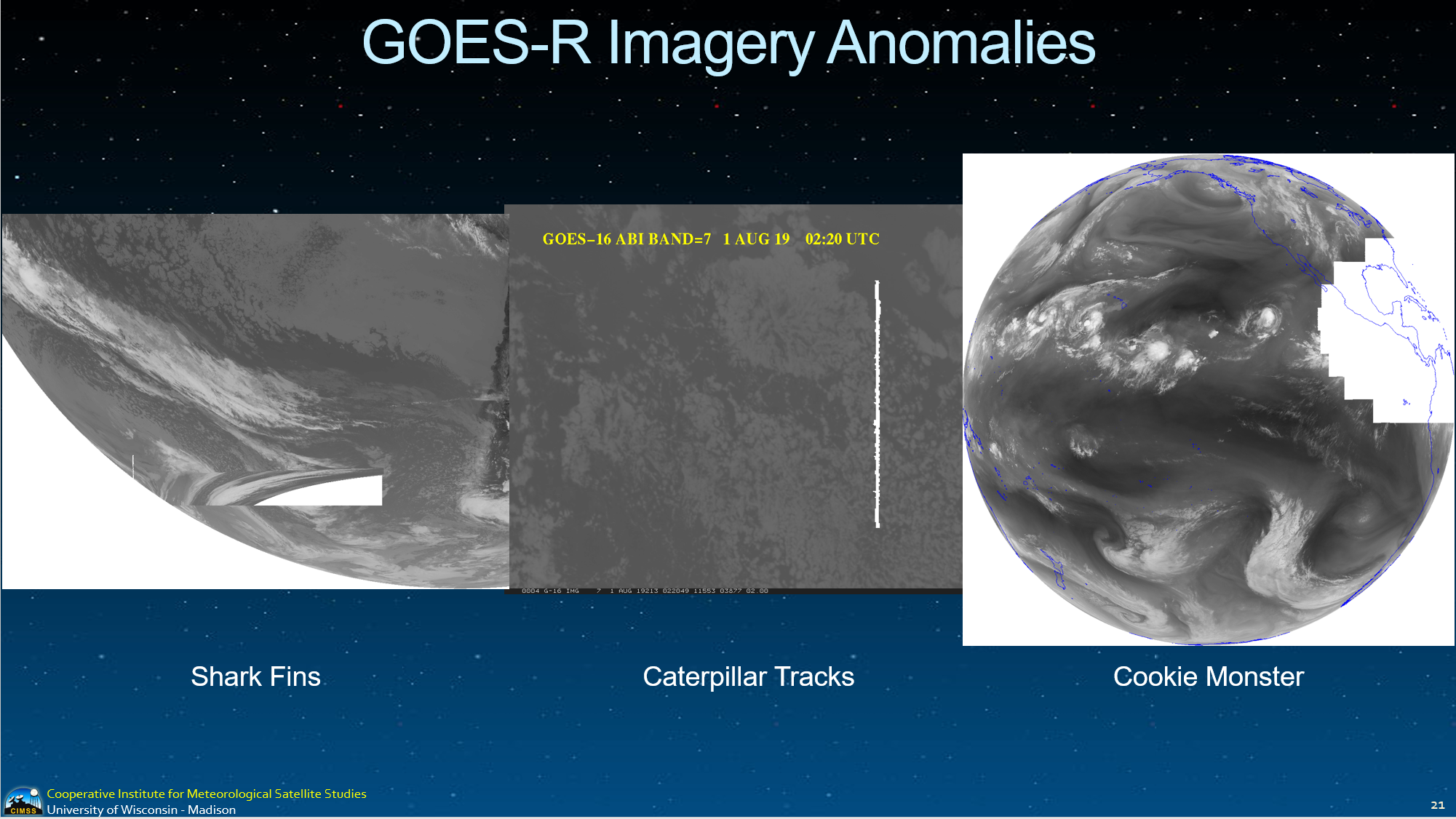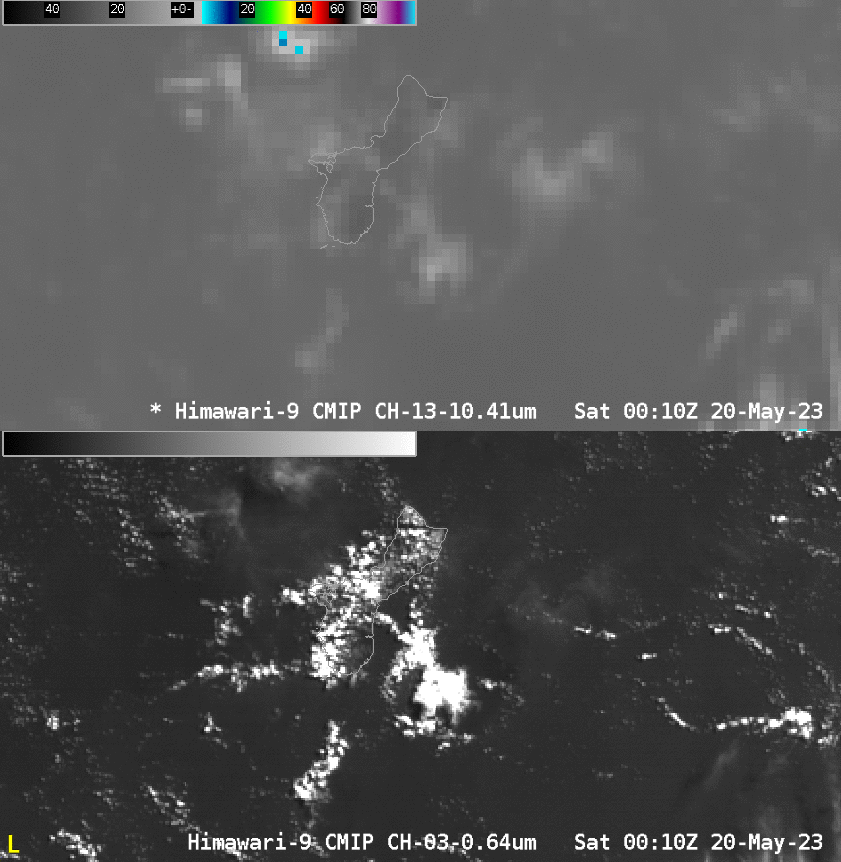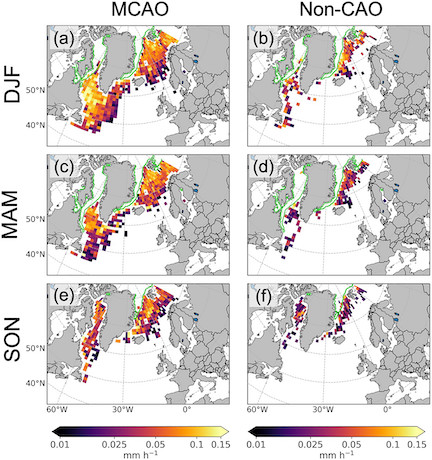
[ Archive ]

 |
CIMSS-NOAA Weekly Report [ Archive ] |
 |
CIMSS AND ASPB WEEKLY HIGHLIGHTS FOR THE WEEK ENDING JUNE 9, 2023
DATA, INFORMATION, AND USE-INSPIRED SCIENCE:
FUTURE OUTLOOK:
AWARDS AND RECOGNITION:
TRAVEL AND MEETINGS:
CIMSS Participation at the Second week of the Hazardous Weather Testbed: The second week at the Hazardous Weather Testbed occurred the week of 5-9 June 2023. This online-only event included seven National Weather Service forecasters working from their home offices and is a follow-on to the one-week in-person event held in May. The Cooperative Institute for Meteorological Satellite Studies (CIMSS) provided products and subject matter experts for three of the products demonstrated. ProbSevere version 3 and LightningCast Probability products were supplied and described by John Cintineo and Justin Sieglaff. Feedback from HWT helps to guide future directions of ProbSevere and LightningCast development. Polar Hyperspectral Sounding with Microwave and ABI model output (PHSnMWnABI, PHS for short) was supplied and guided by Bill Smith, Sr. and Scott Lindstrom. PHS model output was used to help forecasters focus on locations where convection might be occurring in the next 2-6 hours. HWT continues for a final week on June 12th. Forecaster reactions/evaluations on these (and other products) can be read at this blog: https://inside.nssl.noaa.gov/ewp/. (J. Cintineo, J. Sieglaff, W. Smith Sr., S. Lindstrom, CIMSS, 608 263 4425)
ABI data quality presentation at Unidata Users Workshop: Cooperative Institute for Meteorological Satellite Studies (CIMSS) researcher Mat Gunshor gave an invited talk at the 2023 triennial Unidata Users Workshop. The workshop was held on the Colorado University campus in Boulder from June 5-8, 2023 and had the theme "Storytelling with Earth System Science Data: Challenges and Opportunities for Effective, Ethical, and Reproducible Science." Gunshor's presentation, "GOES ABI Data Quality", was a tutorial on how to use Advanced Baseline Imager (ABI) data, the data quality flags, and pitfalls for users to avoid. (M. Gunshor, CIMSS, 608-263-1146, matg@ssec.wisc.edu)
 (Click image to enlarge)
(Click image to enlarge)
Figure: Some of the GOES-R ABI Imagery Anomalies users learned about at the 2023 Unidata Users Workshop.
TRAINING AND EDUCATION:
MEDIA INTERACTIONS AND REQUESTS:
SOCIAL MEDIA AND BLOG Posts:
SSEC and CIMSS Scientists in the News: Scientists at the University of Wisconsin-Madison (UW) Space Science and Engineering Center (SSEC) and the Cooperative Institute for Meteorological Satellite Studies (CIMSS) provide expert interviews, imagery and case studies to promote science. This week: 1) CIMSS and SSEC imagery were featured in an article published by Mashable about useful sites to track the recent Canadian wildfire smoke: Wildfire smoke maps: 4 best sites for tracking the smoke: https://mashable.com/article/wildfire-smoke-maps. 2) CIMSS Satellite Blog contributors Scott Lindstrom, Scott Bachmeier, and Alexa Ross published these case studies: “Lightning detection with strong convection” (June 08, 2023), "Polar Hyperspectral data in a Numerical Model at HWT" (June 08, 2023), "Eruption of Kilauea" (June 07, 2023), When two JPSS satellites are necessary" (June 05, 2023), "Canadian wildfire smoke dips into United States again" (June 05, 2023), "Wildfires in Quebec (which eventually produced pyrocumulonimbus clouds)" (June 04, 2023), "The curious case of the circular sunglint" (June 02, 2023), "LightningCast and the Air Force Academy graduation" (June 01, 2023). Read more at the CIMSS Satellite Blog: https://cimss.ssec.wisc.edu/satellite-blog/. (S. Lindstrom, CIMSS, S. Bachmeier, CIMSS, A. Ross, CIMSS, 608-263-6765, E. Verbeten, SSEC)
 (Click image to enlarge)
(Click image to enlarge)
Figure: Cloud debris exists near the center of this ellipse, and it’s reasonable to assume this is a dying convective feature, and that the ellipse outlines the outward-propagating downdraft. The animation of Himawari Clean Window infrared (Band 13, 10.4 µm) and visible imagery (Band 3, 0.64 µm), below, from 0010 to 0100 UTC on 20 May, shows motion cloud features consistent with that theory.
PUBLICATIONS:
Marine Cold Air Outbreak Snowfall Manuscript Published: A manuscript titled "Marine Cold-Air Outbreak Snowfall in the North Atlantic: A CloudSat Perspective" was recently published in the Journal of Geophysical Research - Atmospheres. The lead author was Marian Mateling (Cooperative Institute for Meteorological Satellite Studies, CIMSS), while Mark Kulie (NOAA/NESDIS/STAR) and Tristan L'Ecuyer (CIMSS) were co-authors. This study illustrates how marine cold-air outbreaks (MCAO) influence snowfall production and associated cloud properties in the North Atlantic Ocean using CloudSat spaceborne radar observations and products. Comparisons are also made between MCAO and non-MCAO snowfall events in this region, with further attention paid to the region around Svalbard that has hosted intensive field campaign observations in recent years. Citation: Mateling, M., C. Pettersen, M.S. Kulie, and T.S. L'ecuyer, 2023: "Marine Cold-Air Outbreak Snowfall in the North Atlantic: A CloudSat Perspective". JGR-Atmospheres, https://doi.org/10.1029/2022JD038053. (M. Kulie, E/RA2, 608-263-6583, mark.kulie@noaa.gov)
 (Click image to enlarge)
(Click image to enlarge)
Figure: Seasonal mean (January 2007-December 2010) gridded CloudSat 2CSNOW rates during MCAO (left) and non-MCAO (right) conditions. The green line indicates seasonal mean sea ice extent from the ERA5 dataset.
OTHER:
| Archived Weeklies Page | Submit a report item |